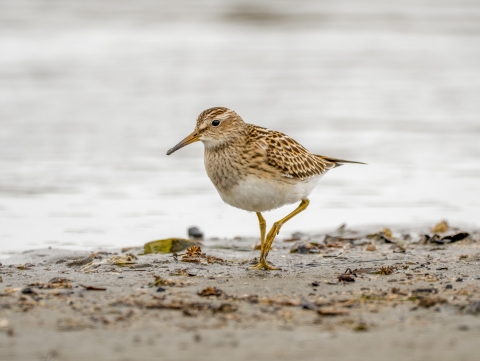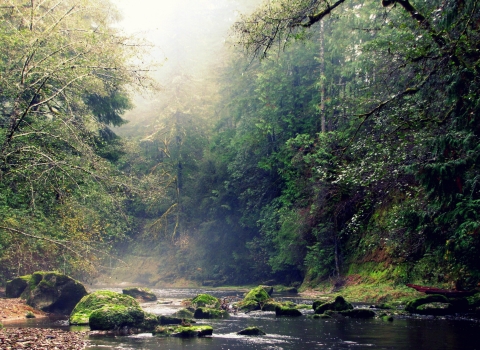PORTLAND, Oregon – With temperatures on the rise and spring upon us, Pacific Coast beaches beckon humans to the shore. In fact, the Long Beach Razor Clam Festival, in Washington, alone is expected to draw about 7,500 clam diggers to the shore when it returns May 10 and 11.
But humans aren’t the only species keenly interested in seeing what low tide has to offer this time of year. This year’s clam festival coincides with the arrival of a massive number of shorebirds.
Vanessa Loverti, shorebird biologist for the U.S. Fish and Wildlife Service’s Pacific Region, explains Washington’s coast is a crucial stop for hundreds of thousands of migratory birds as they move from their winter homes as far away as South America to their breeding grounds in the Arctic.
“They have a two-week window to fatten up before heading north to breed,” Loverti says. “They forage along our local coastline during low tides to get the resources they need to continue their long journey. Human activities can slow that down and take away those opportunities, but there are things people can do to help shorebirds.”
Human help is crucial because the number of shorebirds like Western sandpiper, dunlin and dowitchers are declining. Between 1980 and 2019, 26 of 28 shorebird species were found to be on the decline, with more than half of them losing more than 50% of their population during that time, according to a study published in the May 2023 journal Ornithological Applications. Human disturbance has been identified by the Atlantic Flyway Shorebird Initiative as the greatest threat to shorebirds.
Long Beach and Willapa Bay, between Grays Harbor and the Columbia River Estuary, represents the largest remaining area of tidal mudflat habitat and coastal salt marsh salt marsh
Salt marshes are found in tidal areas near the coast, where freshwater mixes with saltwater.
Learn more about salt marsh habitat in southwestern Washington. It is also the second-largest estuary on the U.S. Pacific Coast. Willapa Bay’s waters recede at low tides to expose nearly 50,000 acres of mudflats, prime feeding areas for shorebirds. The 27-mile-long Long Beach Peninsula provides critical beach and dune habitats, with large proportions of shorebirds roosting on the peninsula’s outer beach. At least 43 species of shorebirds have been recorded on Willapa Bay or Long Beach Peninsula.
So, what can clam dig festivalgoers and other beach enthusiasts do to help these birds rest and fatten up for the long flights ahead?
- Give them their space. These nomads need space to rest, nest and forage. If you can, give them 600 feet or more of space while walking along the beach.
- Keep your dog leashed around large flocks of shorebirds to discourage them from chasing them. If shorebirds are scared of humans, they’re terrified of dogs. They only think in terms of predator. Even the bestest doggies ever may ignore commands when they’re excited.
- Slow down or avoid driving on the beach. In addition to flushing birds, drivers may inadvertently crush nests or cause other harm. Be cautious that roosting shorebird may be resting in high dune habitats, but also like to forage and rest in the wrack line, where seaweed, driftwood and other materials wash up during high tide.
- Bird photographers can lead by example by using a telephoto lens, taking pictures from a safe distance and respecting shorebirds’ space.
- Kites and drones can be terribly off-putting for these migrating birds. Please keep kites at home until shorebirds are gone in a couple of weeks. And be aware that because drones are defined as aircraft, they are subject to the Airborne Hunting Act, which includes protections for birds from harassment by drones.
- Support the protection of wetlands and mudflat habitats.
- If you eat seafood, select sustainable fisheries-certified seafood that is bird safe. A guide is available at the Monterey Bay Aquarium’s website. And eat rice! Rice fields provide excellent habitat for migrating shorebirds. Buy sustainably grown rice from U.S. producers.
By following these tips, human beachgoers can help their feathered friends enjoy a safe and successful journey.
###
The U.S. Fish and Wildlife Service works with others to conserve, protect and enhance fish, wildlife, plants and their habitats for the continuing benefit of the American people. For more information, visit https://www.fws.gov/about/region/pacific and connect with us on social media: Facebook, Instagram, Twitter, LinkedIn, Flickr, and YouTube.




